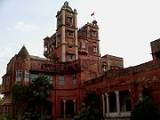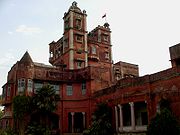
Nareshchandra Singh
Encyclopedia
Raja Nareshchandra Singh (b. 21 November 1908 — d. 11 September 1987), former ruler of Sarangarh
Princely State in Raigarh District
, Chhattisgarh
and Indian National Congress
politician was a former Chief Minister of undivided Madhya Pradesh.
Raja Nareshchandra Singh was the last ruler of the Princely State of Sarangarh in the modern state of Chhattisgarh in Central India. He ruled after the death of his father Raja Jawahir Singh in January 1946 till the merger of his State into the union of India on 1 January 1948.
 . An alumnus of the Rajkumar College, Raipur
. An alumnus of the Rajkumar College, Raipur
in the footsteps of his father, Naresh Chandra Singh worked as an Honorary Magistrate in Raipur district before being inducted as the Education Minister in the administration of Sarangarh State.
After Independence, he joined Indian national Congress Party
and won the first General Election held in 1952 to the State assembly of (old) Madhya Pradesh. He was made a cabinet minister in the cabinet of Pandit Ravi Shankar Shukla and was given the portfolio of Electricity and Public Works Departments.
His tenure is remembered for the conceptualization and creation of a separate and full fledged directorate and department for the development and welfare of the tribals with focussed state policies on these matters. A bridge on the River Mahanadi at Arang near Raipur on the Great Eastern Road in 1954 linked Madhya Pradesh, and after the bifurcation of the State, Chhattisgarh, to Orissa for the first time through an all weather motorable road. It opened gates for trading between the regions, that has flourished since then. He is credited with the smooth bifurcation of assets and manpower of the electricity department between the States when the new Madhya Pradesh came into being on 1 November 1956. This bifurcation planted the seed of what later came to be known as Madhya Pradesh Electricity Board.
A RajGond tribal himself, he was famous for his rapport with, and popularity amongst the vast tribal population of Madhya Pradesh. An avid reader, he was equally famous for the rich library he possessed in his palace in Sarangarh, Chhattisgarh. He won the second, third and fourth general elections too and was a minister throughout in different Congress Ministries in Madhya Pradesh. in 1969 he became the Chief Minister for 13 days (13 March 1969 to 25 March 1969). Disgusted with the way politics had come to be practised, he resigned the office of the chief ministership and membership of the State Assembly simultaneously and quit politics.
His wife Rani Lalita Devi (died 7 November 1987) was elected unopposed in his place in the by-election that was held after his resignation. His daughters continued to be in public life: the eldest, Rajnigandha Devi
was a Member of Parliament (Lok Sabha 1967-71), Kamala Devi was a member of State Assembly of Madhya Pradesh from 1971 to 1989, and a minister for 15 years, Pushpa Devi Singh was thrice elected to the Lok Sabha
Parliament in 1980, 1985 and 1991. The fourth daughter Dr. Menka Devi is engaged in social work in the fields of Community Medicine and Education along with her husband Dr.Parivesh Mishra. The youngest, Purnima Singh is married to Mr. Steve Ellison and is into business. His son Shishir Bindu Singh did nor join political or public life. His grandchildren are Nandita and Chandraveer (daughter and son of Rajnigandha Devi), Mrinalika Singh, born 23 May 1978 (daughter of Kamala Devi Singh) and Kulisha Mishra, born 19 February 1986, currently pursuing her post-graduate studies in Law in the Nottingham University(daughter of Dr. Menka Devi and Dr. Parivesh Mishra)
Sarangarh
Sarangarh is a town and a nagar panchayat in Raigarh district in the Indian state of Chhattisgarh.-Demographics: India census, Sarangarh had a population of 14,458. Males constitute 51% of the population and females 49%. Sarangarh has an average literacy rate of 70%, higher than the national...
Princely State in Raigarh District
Raigarh District
Raigarh district is a district of the state of Chhattisgarh, in India. Raigarh is the district headquarters.The languages spoken in the district are Chhattisgarhi, Oriya and Hindi....
, Chhattisgarh
Chhattisgarh
Chhattisgarh is a state in Central India, formed when the 16 Chhattisgarhi-speaking South-Eastern districts of Madhya Pradesh gained separate statehood on 1 November 2000....
and Indian National Congress
Indian National Congress
The Indian National Congress is one of the two major political parties in India, the other being the Bharatiya Janata Party. It is the largest and one of the oldest democratic political parties in the world. The party's modern liberal platform is largely considered center-left in the Indian...
politician was a former Chief Minister of undivided Madhya Pradesh.
Raja Nareshchandra Singh was the last ruler of the Princely State of Sarangarh in the modern state of Chhattisgarh in Central India. He ruled after the death of his father Raja Jawahir Singh in January 1946 till the merger of his State into the union of India on 1 January 1948.

Rajkumar College, Raipur
Rajkumar College in Raipur is one of the old K-12 foundation of India. RKC has spacious buildings, grounds and play fields. The whole estate is spread over an area of 115 acres.-History:...
in the footsteps of his father, Naresh Chandra Singh worked as an Honorary Magistrate in Raipur district before being inducted as the Education Minister in the administration of Sarangarh State.
After Independence, he joined Indian national Congress Party
Indian National Congress
The Indian National Congress is one of the two major political parties in India, the other being the Bharatiya Janata Party. It is the largest and one of the oldest democratic political parties in the world. The party's modern liberal platform is largely considered center-left in the Indian...
and won the first General Election held in 1952 to the State assembly of (old) Madhya Pradesh. He was made a cabinet minister in the cabinet of Pandit Ravi Shankar Shukla and was given the portfolio of Electricity and Public Works Departments.
His tenure is remembered for the conceptualization and creation of a separate and full fledged directorate and department for the development and welfare of the tribals with focussed state policies on these matters. A bridge on the River Mahanadi at Arang near Raipur on the Great Eastern Road in 1954 linked Madhya Pradesh, and after the bifurcation of the State, Chhattisgarh, to Orissa for the first time through an all weather motorable road. It opened gates for trading between the regions, that has flourished since then. He is credited with the smooth bifurcation of assets and manpower of the electricity department between the States when the new Madhya Pradesh came into being on 1 November 1956. This bifurcation planted the seed of what later came to be known as Madhya Pradesh Electricity Board.
A RajGond tribal himself, he was famous for his rapport with, and popularity amongst the vast tribal population of Madhya Pradesh. An avid reader, he was equally famous for the rich library he possessed in his palace in Sarangarh, Chhattisgarh. He won the second, third and fourth general elections too and was a minister throughout in different Congress Ministries in Madhya Pradesh. in 1969 he became the Chief Minister for 13 days (13 March 1969 to 25 March 1969). Disgusted with the way politics had come to be practised, he resigned the office of the chief ministership and membership of the State Assembly simultaneously and quit politics.
His wife Rani Lalita Devi (died 7 November 1987) was elected unopposed in his place in the by-election that was held after his resignation. His daughters continued to be in public life: the eldest, Rajnigandha Devi
Rajni Devi
Mrs Rajnigandha Devi was the daughter of Raja Naresh Chandra Singh, and former member of parliament. Born at Girivilas Palace, Sarangarh on 31 January 1937, she studied in St Joseph's Convent Nagpur and at Lady Amrit Bai College of Nagpur University. In 1967, she was elected to the 4th Lok Sabha...
was a Member of Parliament (Lok Sabha 1967-71), Kamala Devi was a member of State Assembly of Madhya Pradesh from 1971 to 1989, and a minister for 15 years, Pushpa Devi Singh was thrice elected to the Lok Sabha
Lok Sabha
The Lok Sabha or House of the People is the lower house of the Parliament of India. Members of the Lok Sabha are elected by direct election under universal adult suffrage. As of 2009, there have been fifteen Lok Sabhas elected by the people of India...
Parliament in 1980, 1985 and 1991. The fourth daughter Dr. Menka Devi is engaged in social work in the fields of Community Medicine and Education along with her husband Dr.Parivesh Mishra. The youngest, Purnima Singh is married to Mr. Steve Ellison and is into business. His son Shishir Bindu Singh did nor join political or public life. His grandchildren are Nandita and Chandraveer (daughter and son of Rajnigandha Devi), Mrinalika Singh, born 23 May 1978 (daughter of Kamala Devi Singh) and Kulisha Mishra, born 19 February 1986, currently pursuing her post-graduate studies in Law in the Nottingham University(daughter of Dr. Menka Devi and Dr. Parivesh Mishra)

